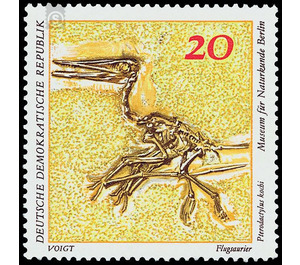Paleontological collections from the Museum of Natural History in Berlin - Germany / German Democratic Republic 1973 - 20 Pfennig
Theme: Architecture
| Country | Germany / German Democratic Republic |
| Issue Date | 1973 |
| Face Value | 20.00 |
| Color | brown |
| Perforation | K 13 |
| Printing Type | Photogravure |
| Stamp Type | Postage stamp |
| Item Type | Stamp |
| Chronological Issue Number | 1566 |
| Chronological Chapter | GER-DDR |
| SID | 403679 |
| In 33 Wishlists | |
Paleontological collections from the Museum of Natural History in Berlin The Ministry of Posts and Telecommunications of the German Democratic Republic publishes six multicolored special postage stamps depicting motifs of paleontological collections from the Museum of Natural History in Berlin. Paleontological collections from the Museum of Natural History Berlin The fossils from the paleontological collections of the Museum of Natural History Berlin on the special stamps are particularly valuable original witnesses of the history of life on earth. They are both research objects and simultaneously used illustrative material in the educational work of the museum. The Museum of Natural History Berlin - an institution of the Humboldt University - preserves, maintains and extends, among other natural history collections, the largest paleontological collection of the GDR with about 15 million objects. 20 Pfennig value: Pterosaur, Pterodactylus kochi; WAGLER The conquest of airspace by vertebrates is one of the most important events of the Jurassic period. The pterodactyls (Pterosauria) had already reached a level of development in the upper Jurassic, which reached the birds only in the upper Cretaceous period. Their flying ability was partly excellent, with the high development of the brain associated with it. A hairiness of the body indicates warm-bloodedness. The pictured skeleton was found in the Solnhofener Plattenkalken and has a length of about 20 cm. From the enormously extended fourth finger, the flight skin stretched to the body. Pterodactylus - he was not such a good flyer - lived on the shores of the Jura Sea about 130 million years ago.


